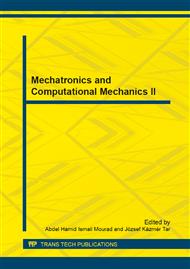p.301
p.306
p.311
p.315
p.319
p.326
p.332
p.339
p.343
Research on Lower-Order Body Matrix Method and the Configuration Transformation of Planar Metamorphic Mechanism
Abstract:
The lower-order body matrix method is proposed as to topological configuration issue of planar metamorphic mechanism. Through combining lower-order operator and type code of kinematic pair, the lower-order body matrix is built to describe the information of adjacent body and kinematic pair. In the research on configuration transformation of planar metamorphic mechanism, step-description method is put forward which adapts to the analysis of various planar metamorphic ways. Step mathematical equation is established based on the generalized operational rule of lower-order body matrix. Application example shows that the lower-order matrix built with lower-order body matrix method is simpler and more informative, which has many advantages over the adjacency matrix and the correlation matrix that cannot be combined with the kinematics and dynamics equations, and solve the issue that the low-order sequences can only describe the open chain metamorphic mechanism. Step-description method can describe various planar metamorphic configuration transformation process comprehensively, which the EU matrix method cannot complete, providing a new method on the research of planar metamorphic mechanism.
Info:
Periodical:
Pages:
332-338
Citation:
Online since:
February 2014
Authors:
Price:
Сopyright:
© 2014 Trans Tech Publications Ltd. All Rights Reserved
Share:
Citation:


